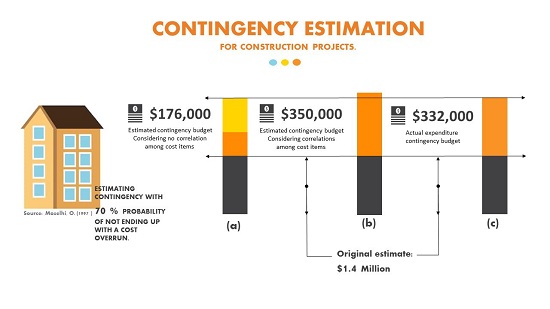 Sunday, May 5, 2024
Sunday, May 5, 2024  Sunday, May 5, 2024
Sunday, May 5, 2024 
Labour disputes, bad weather, delayed city approvals — there are any number of reasons why a construction project gets delayed. And without proper planning, those delays can be extremely costly.
Mohammadjavad Arabpour Roghabadi is a doctoral candidate in the Department of Building, Civil and Environmental Engineering. His research focuses on the correlations between cost items — parts of a project that have associated expenses — in order to help project managers develop more accurate contingency budgets and avoid expensive overruns.
How does this specific image relate to your research at Concordia?
Mohammadjavad Arabpour Roghabadi: This image shows the importance of considering correlations between cost items in estimating a contingency budget for construction projects.
This is a case study of a four-story office building in Montreal with an original cost of $1.4 million. A contingency budget ensures a 70-per cent chance of not experiencing project cost overrun.
Graph (a) shows the estimated contingency without considering correlation between cost items, while graph (b) shows the estimated contingency considering correlations. Since the actual expenditure contingency budget shown in graph (c) is the closest to the estimated contingency in graph (b), we can conclude that the estimated contingency budget is more accurate when considering correlations among cost items.
What is the hoped-for result of your project?
MAR: My work on contingency estimating leads to realistic and reliable cost estimates of construction projects, which alleviate problems of cost overruns that are so prevalent in current industry practice.
The accuracy of contingency estimating heavily relies on the calculation of correlations between cost items. However, this requires a great deal of historical records of cost data that are not often available. In the absence of the historical records, contractors estimate correlations between cost items qualitatively based on their gut feeling and experience.
The objective of my research is to develop a method enabling contractors to estimate contingency, either based on their historical records of cost data — if any — or the experience and judgment of the contractors. As such, the method provides considerable flexibility in estimating project cost contingency to accommodate situations where historical records of cost data may not be available.